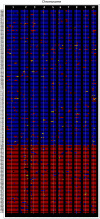B73-Mo17 near-isogenic lines demonstrate dispersed structural variation in maize
- PMID: 21705654
- PMCID: PMC3149956
- DOI: 10.1104/pp.111.174748
B73-Mo17 near-isogenic lines demonstrate dispersed structural variation in maize
Abstract
Recombinant inbred lines developed from the maize (Zea mays ssp. mays) inbreds B73 and Mo17 have been widely used to discover quantitative trait loci controlling a wide variety of phenotypic traits and as a resource to produce high-resolution genetic maps. These two parents were used to produce a set of near-isogenic lines (NILs) with small regions of introgression into both backgrounds. A novel array-based genotyping platform was used to score genotypes of over 7,000 loci in 100 NILs with B73 as the recurrent parent and 50 NILs with Mo17 as the recurrent parent. This population contains introgressions that cover the majority of the maize genome. The set of NILs displayed an excess of residual heterozygosity relative to the amount expected based on their pedigrees, and this excess residual heterozygosity is enriched in the low-recombination regions near the centromeres. The genotyping platform provided the ability to survey copy number variants that exist in more copies in Mo17 than in B73. The majority of these Mo17-specific duplications are located in unlinked positions throughout the genome. The utility of this population for the discovery and validation of quantitative trait loci was assessed through analysis of plant height variation.
Figures





References
-
- Balint-Kurti PJ, Wisser R, Zwonitzer JC. (2008) Use of an advanced intercross line population for precise mapping of quantitative trait loci for gray leaf spot resistance in maize. Crop Sci 48: 1696–1704
-
- Balint-Kurti PJ, Yang J, Van Esbroeck G, Jung J, Smith ME. (2010) Use of a maize advanced intercross line for mapping of QTL for northern leaf blight resistance and multiple disease resistance. Crop Sci 50: 458–466
-
- Balint-Kurti PJ, Zwonitzer JC, Wisser RJ, Carson ML, Oropeza-Rosas MA, Holland JB, Szalma SJ. (2007) Precise mapping of quantitative trait loci for resistance to southern leaf blight, caused by Cochliobolus heterostrophus race O, and flowering time using advanced intercross maize lines. Genetics 176: 645–657 - PMC - PubMed
Publication types
MeSH terms
LinkOut - more resources
Full Text Sources
Other Literature Sources

